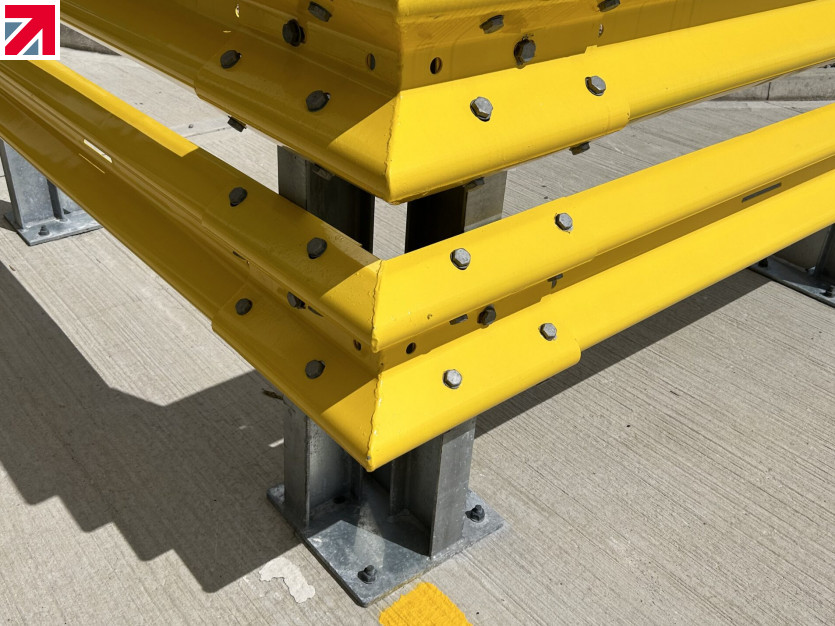The key components of Armco barriers include beams, posts and end sections.
The industry-standard height beam is crucial for providing effective protection. Armco barrier heights can vary, with different Armco barrier heights being used depending on a site’s specific requirements. Can be used internally and externally and is a modular system which is not only quick and easy to install. Any damaged components within the system can easily be replaced.
1. Height and Thickness Standards:
These are defined to ensure the barriers can withstand impacts from vehicles of different sizes and speeds. In a car park application, a post height of 560mm or 610mm high would be most suitable. However, where Heavy Fork Lift Trucks and HGV’s are in operation a 760mm high post is generally considered the industry standard. An 1100mm high post double rail system is also a popular solution in areas of heavy traffic of HGV’s as they are more visually impactful and also give higher protection. Other heights of posts are also available and can be fabricated to any specification.
2. Length and Spacing Requirements:
The barriers must be aligned with the road curvature and area type. The length and spacing of Armco barriers are meticulously calculated to provide continuous protection while accommodating natural and man-made features of the installation area. Typically Armco barriers are mounted on posts at either 3.2m centres or for additional strength/protection at 1.6m centres.
3. Installation Procedures:
These specify anchoring methods appropriate for different ground surfaces, which is crucial for maintaining barrier stability. The procedures involve selecting the right anchoring techniques based on ground type, ensuring the barriers remain firmly in place even upon impact.
Armco posts are generally either bolted down to a concrete floor or concreted in.
Where an Armco system is required on a tarmac surface this is considered to be a ‘grey area’ in terms of bolting down. Tarmac ground fixings are available but we always advise that the posts dug into the ground and concreted in.
4. Material Quality Compliance:
Armco barriers are required to be made from high-grade, galvanised steel. This ensures durability and resistance to corrosion, factors essential for the long-term effectiveness and minimal maintenance of the barriers.
5. Impact Resistance Criteria:
These standards ensure that Armco barriers can effectively absorb and distribute the force from vehicle collisions, minimising damage to both the vehicle and the barrier itself and, more importantly, protecting the occupants of the vehicle.
6. Environmental Adaptability:
There are specific guidelines for barrier installation in different environmental conditions, such as coastal areas or regions with extreme weather. These guidelines ensure that the barriers maintain their integrity and functionality regardless of environmental challenges, such as saltwater corrosion or temperature extremes.
Installation Considerations for Different Dimensions
The installation of Armco barriers requires meticulous planning, taking into account their dimensions. The total length of the barrier is a critical factor, as it must align with the specific requirements of the site to provide effective protection.
Larger barriers, or those installed in areas with unique dimensions, such as sharp corners or spaces with low ground clearance, demand special attention during installation to ensure they deliver maximum safety and efficiency. Furthermore, understanding the armco barrier prices in relation to their sizes and specifications is vital for budgeting in construction and safety projects.
Armco Barrier Dimensions FAQs
What Are Crash Barriers?
Crash barriers, such as Armco crash barriers, are essential safety installations predominantly used in off highway installations. Their primary function is to prevent damage to pedestrians, plant and infrastructure, thereby significantly reducing the risk of serious accidents. These barriers are crucial in enhancing site safety, effectively acting as a protective shield that absorbs and deflects the impact of a vehicle collision. This function is particularly vital in areas with high traffic volumes or near pedestrian zones, where the consequences of a vehicle losing control can be particularly severe.
What Size Are Armco Barriers?
Armco barriers’ size varies to cater to different safety needs and location-specific requirements. They are typically available in multiple lengths, allowing for continuous coverage across extended areas. The height of these barriers also varies, tailored to the specific environment in which they are installed. This adaptability in size ensures that Armco barriers can be effectively used in a wide range of settings, from industrial warehousing etc to commercial premises and car parks.
What Height Should Armco Barriers Be?
The appropriate height for Armco barriers is determined based on the specific location and the type of traffic it encounters. For instance, barriers intended to protect pedestrian areas might be lower to prevent obstruction, while those in high-speed vehicle zones may be taller to offer better containment. The selection of the right Armco barrier height is crucial for ensuring that the barrier performs effectively in its intended role, whether it’s safeguarding pedestrians, securing vehicle-heavy areas, or protecting property and infrastructure from vehicular damage.
Find out more about Armco Barrier Supplies on their member profile page here
Member-created content 3 weeks ago | From members
